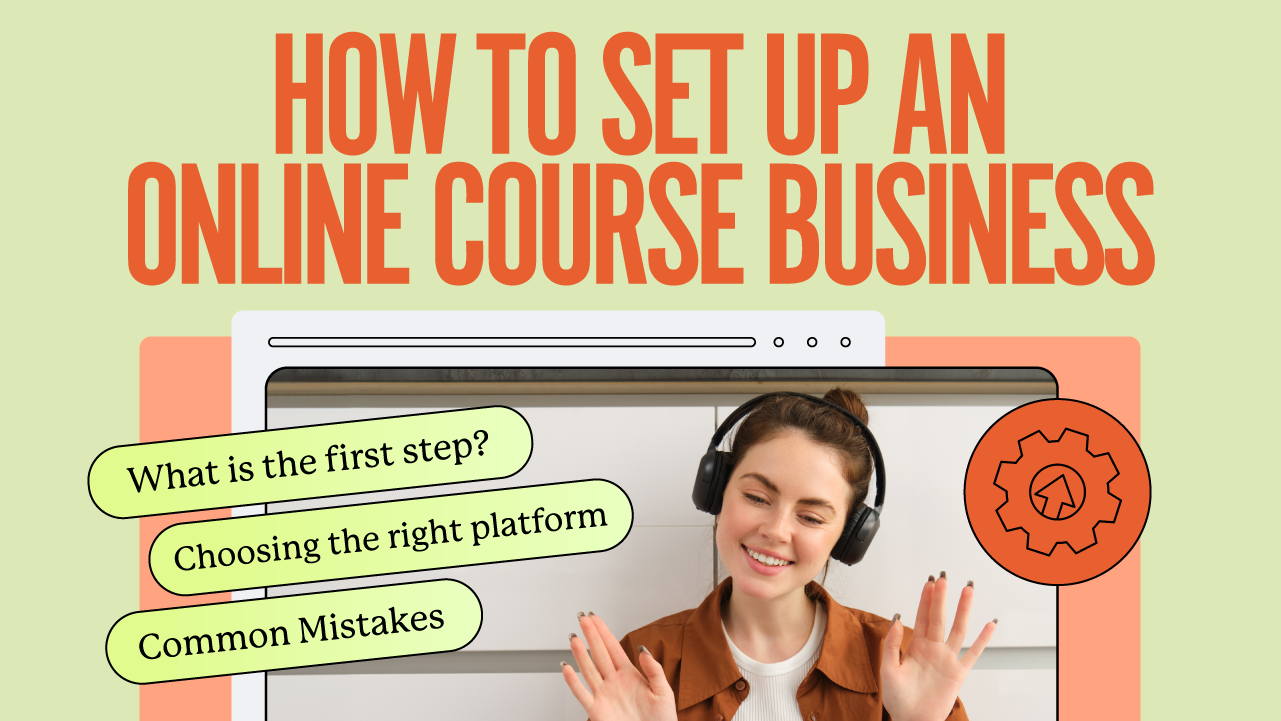
How To Set Up An Online Course Business: Step-By-Step In 2024
Get free expert insights and tips to grow your knowledge business sent right to your inbox.
According to a Valuates Reports E-learning Marketing Report, the online learning industry will be worth more than $370 billion by 2026. So, now is an excellent time to start an online course business.
But like any business, you need good planning and smart ideas to succeed. Every step matters, from finding a niche topic to designing good courses and marketing them. One wrong move can ruin your online course business.
Where do you even begin? With countless platforms to choose from, endless marketing strategies, and the overwhelming need to create high-quality content, it's easy to feel paralyzed before you even start.
We'll walk you step-by-step through building a successful online course business. You'll learn to spot the most profitable course ideas, choose the ideal platform for your needs, and attract a loyal audience eager to learn from you.
12 Steps On How To Set Up An Online Course Business
Here are 12 steps on how to set up a successful online course business:
- Market Research and Validation
- Develop Your Business Plan
- Choose a Platform
- Course Development
- Scaffolding and Active Learning
- Build an Online Learning Community
- Select a Business Model
- Create a Conversion-Driven Course Page
- Set Up a Sales Funnel
- Implement Ongoing Marketing Strategies
- Monitor and Enhance Course Quality
- Expand Your Course Offerings
This checklist guides you through everything to create a successful online course business.
1. Market Research And Validation
Doing market research should be the first step when you have an idea for an online course. This means deeply understanding your target audience and the current competition.
Then, proper validation will confirm there is demand and room for your ideas. It will also shape the specifics of your content strategy and business approach.
Identify Your Niche
To kick off, you need to pinpoint the niche you want to focus on. It should be a subject area that interests you and one that you are knowledgeable about. Look into current trends within your field and identify emerging needs that your course could fulfill. This initial step sets the direction for your entire project.
Why does having a niche matter?
- Trying to teach "everything" results in a watered-down course. Being known for a specialty builds authority.
- A crowded general market is harder to compete in. A niche lets you shine.
- Your marketing gets laser-focused, making everything easier.
For example, instead of building an online course on "social media marketing," focus on “Instagram marketing techniques for personal trainers.” Obsessing over niches leads to focused content and better solutions.
Not sure what your niche is? Grab our free guide and learn how to find your niche in less than 10 minutes.
{{find-niche}}
Understand Pain Points And Goals
Once you've identified your niche, the next step is to understand your audience's pain points and goals:
- What struggles does your audience face?
- What goals do they want to achieve?
To understand the pain points, first, create a detailed profile of your ideal student, including demographic details, learning goals, and challenges.
Tools like Google Analytics, social media insights, and forums related to your niche can provide valuable data. Understanding your audience helps in tailoring your course to their needs.
Frame your niche around resolving frustrations and helping students accomplish the outcomes they desire from the learning experience.
Explore popular forums, Facebook Groups, subreddits, and online communities for your target audience. Review recent discussions and comments for common questions, frustrations, and desires people post about.

Research The Competition Thoroughly
This next step is to analyze your competition. Use search engines and online course platforms to see who else is offering courses similar to what you have in mind.
Take note of their course content, how they price their courses, and the feedback they receive from students. This will give you a clearer picture of what works, what doesn’t, and where there might be gaps that your course can fill.
Ask yourself these questions:
- What do they do well?
- Where is there room for improvement?
- What topics do they cover? What’s missing?
- What do students rave about?
- What are their complaints?
- What business models and pricing do they use?
- What messaging and selling approaches engage their audience?
This uncovers hidden needs you can address. Gaps show you opportunities to meet unmet needs.
Validate Demand With Keyword Research
Next, do keyword research. Keyword research reveals search volume data — the quantifiable demand for specific topics. It also helps optimize marketing later.
Using platforms like Google’s Keyword Planner, Semrush, or Ahrefs can help you identify the terms and topics your potential students are searching for.

In this step, many often ask themselves, is a keyword with very high competition good?
High-competition keywords, such as those with very high search volume or existing dominant domains targeting them, will be extremely difficult to rank for as a new website.
The high competition indicates that established sites and authority domains already capture those terms.
Bidding against them for pay-per-click ads will also drive costs high due to the high commercial intent behind these popular searches.
Instead, you'll want to uncover "long-tail" keywords and search queries with solid search volume between 500-5,000 monthly searches. These indicate decent demand from real users but are more targeted and niche-specific phrases with much lower competition.
This allows you to carve out space in the rankings to capture organic traffic more easily in less competitive niches. The demand indicates interest, but competition is not yet saturating the keyword so that you can make a play at dominant positioning.
In summary:
✅ Good = 500-5,000 searches per month, low-medium competition
❌ Bad = 100,000+ searches, high competition existing domains
Get Audience Insights
Directly engaging with your potential audience through surveys can provide specific insights into their preferences and needs.
Ask people matching your target niche about their needs, interests, problems, and willingness to pay for solutions like an online course.
Their direct input further validates you are solving real issues, clears up assumptions, and ensures you craft relevant courses they will invest in.
Use tools like SurveyMonkey or Google Forms to create surveys you can distribute via social media, email, or forums.
Pro Tip: Create A Minimum Viable Product (MVP)
Creating an entire course needs a lot of effort. So, before fully committing to developing your entire course, consider creating a Minimum Viable Product (MVP) such as a series of webinars, an eBook, or a mini-course.
This approach allows you to test the market's interest in your course topic with minimal investment. The feedback and engagement from your MVP will help you refine your course concept and content.
Not sure if your product idea will work? Check out our free guide, which will help you validate your idea, find your ideal customer, and discover profitable solutions.
{{product-idea}}
Adjust And Refine Your Concept
Finally, use analytics to validate the demand for your course. Engagement metrics such as page views, time spent on your content, social shares, and comments can strongly indicate interest.
Also, tweak your audience, course topics, and angles until you have confidence they serve a need and capture the voice of who you intend to serve.
While it takes some legwork upfront, proper validation sets your online course up for sustainable success by intentional design instead of guessing. It helps you know if your course will be profitable.
2. Develop Your Business Plan

After checking that your course idea has demand, the next big step is creating a business plan. This will outline how you will build your online course.
Now, a full-blown traditional business plan might be overkill for some online course creators, but taking the time to map out your approach is essential for a focused and sustainable business.
Here are the key parts to include in an online course business plan:
Define Your Target Students
First, be very specific about who your ideal students are. Go beyond just demographics like age and gender. Also, include details about their motivations, interests, goals, and hesitations around buying courses.
Understand what is most important to them in making a purchasing decision. This helps ensure your messaging really connects with their priorities.
Outline Your Course Topics & Delivery
Map out exactly what subjects your courses will cover and how they will be delivered based on the gaps you found in research.
- Will they be self-paced or as a cohort?
- Will you have single courses, bundles, or memberships?
Show how your educational design addresses student needs and gets them closer to their goals.
Explain Your Marketing And Sales Process
Determine precisely how you will attract students and convert sales.
What marketing channels, sales messaging, and tools will compel enrollments? Estimate your cost to acquire a student, too.
Outline website traffic sources, lead capture tactics, and launch sequences you will use.
Market Analysis
Research your target audience, including their demographic details, learning preferences, and challenges they face in the current education market.
Additionally, conduct a competitive analysis to identify your main competitors, their offerings, strengths, and weaknesses. This analysis will help you understand your position in the market and identify opportunities for differentiation.
For market analysis, use SimilarWeb. This (paid) tool lets you analyze website traffic data for competitors to gauge total visits, source channels, and engagement metrics. This reveals high-level performance benchmarks to compare to your own.

Financial Plan
One of the most critical components of your business plan is the financial plan. Start with an initial budget that includes startup costs (website development, course creation software, marketing expenses) and operational costs (hosting fees, salaries, ongoing marketing expenses).
Then, project your revenue streams, including course sales, subscription services, or corporate training programs. Provide financial projections for the first year, broken down monthly, and for the next three to five years annually.
When creating your financial plan, be aware that some platforms like Kajabi offer an all-in-one solution for online course entrepreneurs. Kajabi’s platform includes:
- A website builder
- Course creator tools
- Email marketing tools
- Messaging capabilities
- Marketing funnels
This simplifies financial planning by consolidating costs into one predictable subscription fee.
Risk Analysis
Identify potential risks to your business, such as technological changes, market trends, or competitive pressures, and outline strategies to mitigate these risks. This could include diversifying course offerings, investing in marketing, or keeping abreast of technological advancements in e-learning.
Plan For Continuous Improvements
Think about how you'll keep evaluating and improving each business area using customer feedback and data. Set process improvements to increase profits and impact over time.
While planning is key, stay flexible to change tactics when you see what works. Use your plan as an evolving guide.
With a solid business plan, you now have a detailed map for executing the buildout of your online course.
3. Choose A Platform
The right platform you settle on directly influences the success of your online learning business.
The platform you select significantly impacts your course's accessibility, engagement, and overall student experience. In addition, it influences the efficiency of your marketing efforts, the ease of managing your content, and your ability to scale your business.
For example, if you compare Kajabi vs. Thinkific, you'll find distinct features and benefits. Understanding these differences is key to making an informed decision that aligns with your business goals and the needs of your students.
Kajabi is an all-in-one platform for online course creators, providing course hosting and marketing and sales tools integrated into the same ecosystem.

One of Kajabi's standout features is its robust set of marketing tools.
Thinkific, on the other hand, offers great flexibility and control over the course creation and delivery process. It's well-suited for creators who want detailed control over their course's structure and student experience.
Kajabi is better for sales and marketing, while Thinkific has more student assessment features. Kajabi also offers more features for landing page creation.
Apart from Kajabi and Thinkific, there are tens of online course platforms.
So, how do you know which platform to settle for?
- Understand Your Needs: Understand your requirements. Consider the nature of your courses, the expected volume of students, and the level of interaction you wish to have with them.
- Customization: The ability to customize your online course platform can significantly enhance your brand's visibility and create a unique learning environment for your students. Platforms like Kajabi offer extensive customization options, allowing you to tailor the look and feel of your course pages, landing pages, and email communications.
- Marketing Tools: An ideal platform should offer built-in features like email marketing, landing pages, and sales funnel builders.
- Content Delivery and Engagement Features: Features like video hosting, interactive quizzes, and discussion forums can enhance the learning experience. Additionally, the ability to track student progress, offer certificates of completion, and provide personalized feedback can contribute to a more engaging and rewarding course.
- Scalability: As your online course business grows, you'll need a platform to scale. This means supporting an increasing number of students and courses and offering advanced features like membership sites, affiliate programs, and more sophisticated marketing automation tools.
- Payment and Monetization Options: Your platform should offer flexible payment and monetization options to accommodate different business models. Look for platforms that support multiple payment gateways, offer payment plans, and allow for coupon codes and discounts.
- Support and Community: Finally, consider the level of support and the community surrounding the platform. Additionally, an active community of other course creators can provide insights, advice, and inspiration.
Kajabi offers 24/7 customer support through email and chat, and it has vibrant communities where you can connect and learn from other creators.
While other tools can work, Kajabi specializes in supporting online course creators directly.
Sign up with Kajabi for a 14-day free trial to test our comprehensive features.
4. Develop Your Course
This process involves several key steps — planning your course content, selecting the right delivery methods, and creating engaging materials.
Inventory Your Existing Materials
Begin by taking stock of all the materials you have that are relevant to your course topic.
This could include blog posts, webinar recordings, podcasts, eBooks, or any other content that provides valuable insights into your subject area. Organize these materials in a way that aligns with your course outline.
Define Your Learning Objectives
Start by clearly defining what you want your students to learn or achieve by the end of the course. These objectives should be specific, measurable, achievable, relevant, and time-bound (SMART).
Learning objectives are the foundation for your course, guiding the development of your content and assessments.
Take, for example, the course “Photography Basics: Master Your Camera in 30 Days.”
Overall Course Goal: By the end of this course, students will be able to take professional-looking photographs using their camera's manual mode.
Some broad topics and their SMART learning objectives could be:
- Camera Settings: By the end of Module 1, students will be able to explain the relationship between aperture, shutter speed, and ISO and how to adjust them for different lighting scenarios.
- Composition: By the end of Module 2, students will be able to apply the rule of thirds and leading lines to compose visually appealing photographs.
- Photo Editing: By the end of Module 3, students can use basic photo editing software to adjust exposure and color balance and crop their images.
Identify Gaps And Create New Content
With your existing materials organized, identify any gaps in the content that need to be filled to meet your learning objectives.
For each gap, plan the creation of new content. Ensure that each piece of content directly contributes to achieving a specific learning objective.
Choose The Right Delivery Methods
Different topics and learning objectives require different teaching methods.
For example, teaching concepts like aperture and shutter speed would benefit from combining short, explanatory videos that demonstrate how these settings affect images in real time.
Supplement this with downloadable cheat sheets and diagrams for quick reference. Additionally, provide practice assignments where students submit photos taken with specific settings.
Build Assessments
Assessments are crucial for measuring student progress and ensuring they meet the learning objectives.
Design quizzes, tests, projects, or peer assessments that align with your course goals. Provide clear instructions and criteria for evaluation to maintain transparency and fairness.
Ensure Content Accessibility
Making your course accessible to all learners, including those with disabilities, is essential. This includes:
- Subtitles and Transcripts: Provide subtitles for videos and transcripts for audio content to aid learners who are deaf or hard of hearing.
- Accessible Documents: Ensure downloadable materials are accessible, using clear headings, descriptive links, and alt text for images.
- Responsive Design: Use a responsive platform, ensuring that content is accessible on various devices, including smartphones and tablets.
Pilot Your Course
Consider offering a pilot version of your course to a small group of learners in exchange for detailed feedback.
This can provide insights into how your course is received and highlight areas for improvement before a full launch.
5. Scaffolding And Active Learning
To help students learn step-by-step, use scaffolding when structuring your lessons. Scaffolding means setting up your instruction like building blocks — starting with simpler concepts as the base before advancing to more complex material and skills.
It works like this:
- Introduce the Key Idea. Explain the core concept, like “how to write an effective email subject line,” first without complications. Use examples that isolate the basic skill or fact being learned.
- Add Layers Gradually. Next, provide more use cases, applications, settings, or rules that increase intricacy. In our example, move from general email subject line tips to specifics for e-commerce, then job applications, formal communication, etc. Sequencing easy to difficult allows incremental comprehension.
At each milestone, assess their grasp before progressing.
- Summarize and Check Understanding. Recap key takeaways once complete concepts are covered. Have a final quiz or reflection to help students summarize main ideas or demonstrate new capabilities.
Scaffolding works well because it meets learners where they are and then constructs broader expertise. Use it extensively.
The other core technique, active learning, involves encouraging regular student contribution and interaction.
Design assignments that require students to apply concepts in new and challenging ways. This could include problem-solving exercises, simulations, or creating digital projects.
Scaffolding and active learning strategies support student learning and foster a more engaging and interactive learning environment.
6. Build An Online Learning Community
Don’t just create isolated courses. Facilitate shared learning by building a thriving community among your students.
Humans are social. We discuss ideas, ask questions, and share wins and motivation with others. Your online courses should replicate this collaborative experience.
Here are key ways to foster community:
Create Cohorts
For example, create group sets of students starting/completing courses simultaneously.
This lets them bond around shared milestones and challenges during the learning journey. Assign group projects and discussions to strengthen relationships.
Host Live Events
Weekly or monthly webinars, live Q&As with instructors, and cohort video meetups make learning conversational. This allows students to interact in real time and get personal mentoring.
Provide Collaborative Learning Opportunities
Design assignments that require collaboration, such as group projects or collaborative research. These activities necessitate interaction and can lead to stronger community ties.
Send Regular Emails
Use email check-ins to nourish the community with curated resources, tips, reminders, motivational stories, or progress check-ins. This facilitates instructor guidance and support.
Kajabi has a Communities feature that simplifies the process of building and nurturing an online learning community within its platform.
This feature offers a space that resembles a social network but is focused on your courses and content, facilitating a more engaging and interactive learning environment.
Features of Kajabi Communities include:
- Discussion Forums: Within the community, you can set up forums on various topics related to the course. These forums can host discussions, answer sessions, and collaborative learning efforts.
- Content Sharing: Students and instructors can share resources, articles, videos, and other educational materials directly within the community.
- Announcements and Updates: Instructors can use the community to post announcements, updates, or motivational messages.
- Peer-to-Peer Interaction: The Communities feature facilitates peer-to-peer interactions. Students can participate in discussions and connect with peers with similar interests or goals.
By leveraging this feature, you can create a dynamic, supportive, and engaging environment that motivates students, fosters collaboration, and enhances learning outcomes.
7. Select a Business Model
The business model you choose impacts how you market your courses, engage with your students, and, ultimately, how you generate revenue.
The ideal business model aligns with your content, target audience, and financial goals, offering flexibility as your online course business grows.
Blaine Anderson's success story with Dating By Blaine exemplifies how the right business model can lead to extraordinary success in the online course industry.
Blaine's approach revolves around coaching programs, ranging from self-paced courses to more personalized group and 1-on-1 coaching.
This business model is effective for niches where personal transformation and tailored advice are crucial, such as dating coaching. It allows for premium pricing due to the high value and personalized experience offered to clients.
While Blaine's model emphasizes coaching and personal development, other models in the online course market include:
- Sell Courses Individually: Students pay one fee to get full access to that specific course. For example, you sell a “Baking Cupcakes” online course for a one-time $49 purchase. This is simple but doesn’t bring in money long-term per student.
- Subscription Model: This model, suited for creators with a broad range of content, provides recurring revenue and builds a loyal community. It's effective for topics where ongoing learning and updates are valued, such as tech skills, creative arts, or business strategies.
- Memberships: In this model, you bundle courses into groups that students can access at different tiered pricing levels. For example, your $25 basic cooking membership includes 3 beginner baking courses. The $99 premium membership includes all 15 available advanced cooking courses. This pushes average purchases higher.
- Corporate Training: This targets businesses rather than individuals. Corporate training involves selling your courses to organizations for employee development. This model can lead to larger contracts and a steady client base.
- Freemium Model: The freemium model offers basic course content for free while charging for premium content or additional features. This approach can attract many students and convert a portion into paying customers.
Choosing the right business model for your online course requires a deep understanding of your content, audience, and financial objectives.
Experiment and be flexible. This lets you adapt and refine your business model as your course business evolves.
8. Create A Conversion-Driven Course Page
The goal is to turn visitors into students. You've spent time developing an amazing course and attracting potential students. A low conversion rate means wasted traffic, potential revenue, and all that effort not paying off.
The course page should, therefore, present your course and convince potential students that your course can solve their problems or fulfill their desires.
The page should adhere to SEO best practices.
Consider a hypothetical course titled "Introduction to Digital Marketing: Master Digital Strategies."
Keyword Research And Optimization
Start by identifying the keywords your target audience is searching for.
For the above digital marketing course, relevant keywords might include "digital marketing course," "learn digital marketing," "online marketing class," etc.

- Page Title: Incorporate your primary keyword naturally. E.g., "Introduction to Digital Marketing: Master Digital Strategies | [Your Brand Name]."
- Meta Description: Write a compelling meta description using related keywords. "Dive into digital marketing with our comprehensive online course. Learn SEO, social media, PPC, and more to skyrocket your marketing skills."
- Headings and Subheadings: Use H1 for your main title and H2s for section headings, including keywords where they fit naturally. E.g., "What You Will Learn in This Digital Marketing Course."
Content Optimization
Write a detailed course description incorporating your target keywords. Ensure the content is informative and engaging and outlines the benefits and outcomes of the course.
Integrate long-tail keywords in your content, such as "how to start in digital marketing" or "beginner digital marketing courses online," to capture more specific search queries.
Social Proof And Testimonials
Highlight video testimonials prominently on your course page.
You can create a dedicated section titled "Success Stories" or "Student Testimonials" and optimize it with relevant keywords like "digital marketing course reviews" or "student feedback on digital marketing course."
Remember, 79% of consumers watch a video testimonial to learn more about a brand or product. Incorporating video testimonials from past students or a course preview can significantly boost credibility and conversions.
Clear Calls-to-Action (CTAs)
Your CTAs should be clear, compelling, and include action-oriented language.
For SEO, ensure that anchor texts leading to your course page are descriptive and keyword-rich when linked from other pages or posts. E.g., "Enroll in our digital marketing course today."
Kajabi offers a complete landing page builder, making it easy to create high-converting pages that attract students.
With Kajabi, you can quickly build professional-looking landing pages by customizing flexible templates instead of complex coding. Easily make beautiful pages for lead capture, sales, launches, etc.
Key features include templates for every use case to promote your course effectively. You can create a webinar registration page, coupon giveaway page, or waitlist join page.
Dynamic sections let you fine-tune design on all devices. And you can seamlessly connect landing pages with the rest of your Kajabi ecosystem, like email and course access.
9. Setting Up A Sales Funnel
Think of a sales funnel as a series of steps that guide someone from being vaguely aware of your course to becoming a paying student. Some potential students naturally drop out at each stage of the funnel, which is why it's shaped like a funnel — it gets narrower as you get closer to a sale.

Let’s take an example of how you can set up a sales funnel for an online course on digital marketing.
- Create Awareness: Start by writing informative blog posts about topics related to digital marketing and share these on social media platforms. You could also host a free webinar on a relevant subject, such as "The Top Digital Marketing Trends in 2024." The aim is to provide valuable content that introduces the audience to your expertise and leads them to your course's landing page.
- Build Interest: On your landing page, include an engaging summary of what your course offers, highlighting the unique benefits of taking the course. Use a mix of text, images, and videos to keep the potential customer engaged. Include a signup form where they can leave their email in exchange for a free eBook or course sample.
- Facilitate the Decision: Follow up with an email sequence that provides additional information about the course, shares success stories from past students, and addresses common objections. In the final email of the sequence, make a compelling offer, such as a limited-time discount or an exclusive bonus material, to encourage them to make a decision.
- Encourage Action: Ensure your sales page is optimized for conversions. It should clearly state the course price and what’s included and have an easy-to-use checkout process. At this stage, remove any barriers to purchase. Offer multiple payment options and a money-back guarantee.
Kajabi offers several pre-built funnel templates tailored to common business goals, such as product launches, webinar funnels, and lead magnet funnels.
These templates come with recommended steps and content that you can customize to fit your specific needs.
You also get detailed analytics for each funnel. This way, you can track the performance of your sales funnel. You can see how many people enter your funnel, conversion rates at each step, and overall revenue generated.
Want to write killer copy for your sales pages? Get our free "8 Steps to the Perfect Sales Page" worksheet and learn how to write killer copy that turns website visitors into customers today.
{{perfect-sales}}
10. Implement Ongoing Marketing Strategies
You should continuously get the word out about your courses through different marketing channels to attract new students over time.
First, publish educational blogs and videos optimized for keywords people search related to your niche. This helps them find you in search engines like Google and draws them to your site.
Make great use of social media. As of January 2024, there are over 5.04 billion social media users globally. Share short video clips, graphics, or student success stories on social media platforms your audience uses, like Facebook, Instagram, or TikTok.
Link to free downloads or course discounts in posts to encourage sign-ups.
Other strategies include:
- Email Sequences: When a visitor gives you their email address, trigger a pre-made series of 4-6 automated emails over weeks/months that share tips or course benefits to build interest and guide them to eventually enroll (utilize the sales funnel feature).
- Strategic Partners: Partner with complementary brands and influencers to cross-promote courses and run co-marketing campaigns. Shoutouts, bundled deals, and summits expand awareness.
- Retargeting Ads: If visitors don’t enroll initially, remarket to them through ads on Facebook or Instagram.
- Referrals: Give students unique coupon codes or rewards to share courses with friends for discounts. Word-of-mouth via existing learners works great.
Expert Tip: Analyze cost, conversions, and ROI per channel. This will guide you on where to focus marketing dollars for positive returns.
11. Monitor And Enhance Course Quality
Creating excellent courses is an ongoing effort. Consistently gather student feedback to guide improvements over time.
The best strategy is to prompt students to leave reviews. Positive public reviews build social proof.
Now, don’t be afraid of receiving negative reviews. They are good sources of honest feedback. They indicate where your course may be falling short and offer direct insights into how you can improve.
Expert Tip: Respond to negative feedback promptly and constructively. It demonstrates your commitment to student satisfaction and continuous improvement.
Also, encourage open discussions within your course platform or community forums.
Lastly, regularly send out surveys or questionnaires at the end of your course or module. Ask specific questions about the course content, delivery method, and overall experience to gather actionable insights.
12. Expand Your Course Offerings
Over time, adding more courses at varying skill levels and related topics lets you attract new students while engaging past students more deeply.
Start with newbie courses to build fundamentals. Then, create intermediate and advanced courses to layer on more complex abilities for the same topic.
For example, an initial real estate investing course can be followed by advanced rental property management and commercial real estate investing offerings later.
Also, add courses around related subjects under your niche to capture wider demand.
For instance, expand photography courses into dedicated offerings just on lighting, landscape photography, wedding photography, Adobe Photoshop, and Instagram for photographers.
You can also introduce premium courses. Develop special edition courses with celebrity guest teachers, live interaction through cohorts, or highly tactical skill-building around advanced tactics.
For example, mastermind sessions on copywriting psychology with expert Brian Dean or paid cohorts on building 7-figure agencies.
Final Thoughts
Launching and scaling an online course business is a multifaceted undertaking. It requires careful planning, execution, and ongoing optimization.
From conducting thorough market research to developing high-quality content, choosing the right platform, and implementing effective marketing strategies, each step plays a crucial role in building a successful online education platform.
Platforms like Kajabi simplify execution, accelerating your productivity.
Kajabi’s comprehensive suite of tools—intuitive course builder, customizable landing pages, advanced marketing automation, analytics, secure payments, and funnels—provides you with everything you need to launch and grow your online course business.
Sign up with Kajabi today and explore our full features with a 14-day free trial.
How To Set Up An Online Course Business: Frequently Asked Questions
What Is The First Step In Setting Up An Online Course Business?
Start by conducting thorough market research and validation. Identify a niche that matches your expertise and interests, and deeply understand the needs and preferences of your target audience.
You should also analyze your competitors to identify gaps in the market and opportunities for differentiation. Validating your course idea is critical. You can do this by offering a mini-course or a free webinar to gauge interest. This ensures a demand for your course, laying a solid foundation for your online course business.
How Do I Choose The Right Platform For Set Up My Online Course?
First, consider the platform's ease of use. It should be intuitive for both you and your learners to navigate. Next, assess the platform's content delivery capabilities, including support for various media types like video, text, and interactive quizzes.
Additionally, look into the marketing and sales tools provided, such as email marketing integration, landing page builders, and analytics to track student engagement and course performance.
Also, consider the cost and whether the platform offers the scalability to grow with your business. Finally, check for community features that allow for interaction and engagement among students.
What Common Mistakes You Should Avoid When Setting Up Your Online Course Business?
Don’t skip market research and validation. This will create courses with little demand, wasting valuable time and resources. Ensure you understand your target audience's needs and verify their interest in your course topic before development.
Secondly, underestimating the importance of high-quality content and engaging course design. Invest in professional production and interactive elements to enhance the learning experience.
Additionally, neglecting marketing and student engagement strategies can result in low enrollment numbers. Develop a comprehensive marketing plan and actively engage with your students through forums, email, and social media to build a community around your courses.













